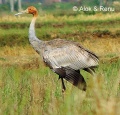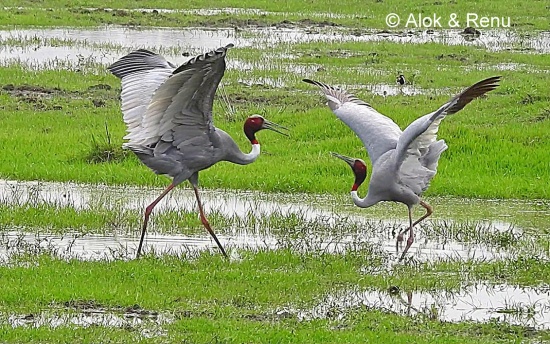
Photo © by Alok Tewari
Keoladeo National Park, Bharatpur, Rajasthan, India, 4 July 2016
- Antigone antigone
Grus antigone
Identification
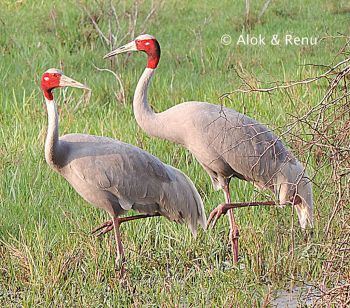
Pair nesting in Keoladeo National Park
Photo © by Alok Tewari
Bharatpur, India, 7 April 2015
176 cm (70 in); male is larger than the female
- Grey plumage
- Bare red head
- White crown
- Long dark pointed bill
- Black wing tips
- Long red or pink legs
Sexes are similar
Young birds are duller and browner.
Distribution
Asia and Australasia
Asia: China, Nepal, Pakistan, India, Eastern and Western Himalayas
Southeast Asia: Indochina, Myanmar, Laos, Vietnam, Cambodia, Brunei, Philippines, Borneo
Australasia: Australia, Northern Territory, Queensland
Taxonomy
Also placed in the genus Grus.
Subspecies
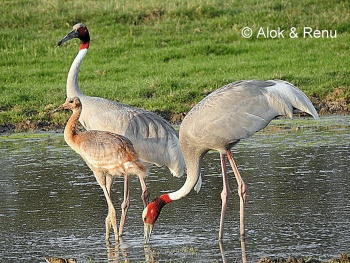
Photo © by Alok Tewari
Keoladeo National Park, Bharatpur, Rajasthan, India, 22 June 2017
There are 3 subspecies[1]:
- A. a. antigone - Northern India to Nepal and (formerly?) Bangladesh
- A. a. sharpii - Cambodia and southern Laos; winters in Vietnam
- A. a. gillae - Spottily distributed coastal northern Australia (mainly Queensland)
Habitat
Freshwater marshes and plains, canals and village ponds.
Behaviour
Male and female engage in repeated, elaborate courtship dance.
Diet
Their diet includes wetland plants, seeds, rice grains ground nuts, also aquatic animals and crustaceans.
Breeding
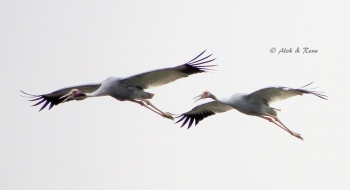
Photo © by Alok Tewari
Keoladeo National Park, Bharatpur, Rajasthan, India, 28 June 2013
They nest on the ground; the clutch consists of 2-3 eggs which is incubated by both adults. They tend to mate for life.
Vocalisation
Recording © by Alok Tewari
Keoladeo National Park, India, July-2016
Call
Gallery
Click images to see larger version
Immature
© by Alok Tewari
Gurgaon Rural, India, 19 March 2014
References
- Clements, J. F., T. S. Schulenberg, M. J. Iliff, D. Roberson, T. A. Fredericks, B. L. Sullivan, and C. L. Wood. 2017. The eBird/Clements checklist of birds of the world: v2017, with updates to August 2017. Downloaded from http://www.birds.cornell.edu/clementschecklist/download/
- Avibase
- Handbook of the Birds of the World Alive (retrieved March 2015)
- AvianWeb
Recommended Citation
- BirdForum Opus contributors. (2025) Sarus Crane. In: BirdForum, the forum for wild birds and birding. Retrieved 5 February 2025 from https://www.birdforum.net/opus/Sarus_Crane
External Links
GSearch checked for 2020 platform.1




